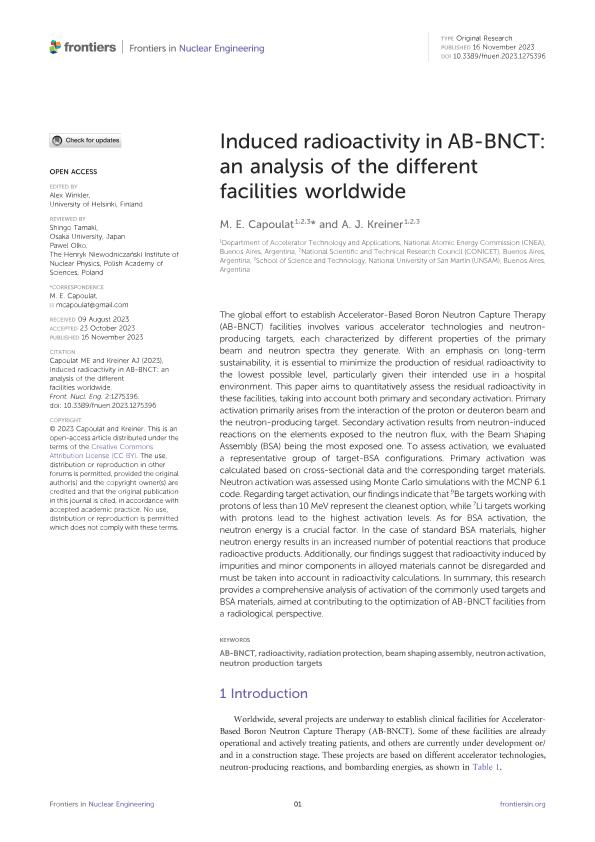Mostrar el registro sencillo del ítem
dc.contributor.author
Capoulat, Maria Eugenia

dc.contributor.author
Kreiner, Andres Juan

dc.date.available
2023-12-27T09:53:56Z
dc.date.issued
2023-11
dc.identifier.citation
Capoulat, Maria Eugenia; Kreiner, Andres Juan; Induced radioactivity in AB-BNCT: an analysis of the different facilities worldwide; Frontiers Media; Frontiers in Nuclear Engineering; 2; 11-2023; 1-15
dc.identifier.issn
2813-3412
dc.identifier.uri
http://hdl.handle.net/11336/221484
dc.description.abstract
The global effort to establish Accelerator-Based Boron Neutron Capture Therapy (AB-BNCT) facilities involves various accelerator technologies and neutron-producing targets, each characterized by different properties of the primary beam and neutron spectra they generate. With an emphasis on long-term sustainability, it is essential to minimize the production of residual radioactivity to the lowest possible level, particularly given their intended use in a hospital environment. This paper aims to quantitatively assess the residual radioactivity in these facilities, taking into account both primary and secondary activation. Primary activation primarily arises from the interaction of the proton or deuteron beam and the neutron-producing target. Secondary activation results from neutron-induced reactions on the elements exposed to the neutron flux, with the Beam Shaping Assembly (BSA) being the most exposed one. To assess activation, we evaluated a representative group of target-BSA configurations. Primary activation was calculated based on cross-sectional data and the corresponding target materials. Neutron activation was assessed using Monte Carlo simulations with the MCNP 6.1 code. Regarding target activation, our findings indicate that 9Be targets working with protons of less than 10 MeV represent the cleanest option, while 7Li targets working with protons lead to the highest activation levels. As for BSA activation, the neutron energy is a crucial factor. In the case of standard BSA materials, higher neutron energy results in an increased number of potential reactions that produce radioactive products. Additionally, our findings suggest that radioactivity induced by impurities and minor components in alloyed materials cannot be disregarded and must be taken into account in radioactivity calculations. In summary, this research provides a comprehensive analysis of activation of the commonly used targets and BSA materials, aimed at contributing to the optimization of AB-BNCT facilities from a radiological perspective.
dc.format
application/pdf
dc.language.iso
eng
dc.publisher
Frontiers Media

dc.rights
info:eu-repo/semantics/openAccess
dc.rights.uri
https://creativecommons.org/licenses/by-nc-sa/2.5/ar/
dc.subject
AB-BNCT
dc.subject
RADIOACTIVITY
dc.subject
RADIATION PROTECTION
dc.subject
BEAM SHAPING ASSEMBLY
dc.subject.classification
Otras Ingenierías y Tecnologías

dc.subject.classification
Otras Ingenierías y Tecnologías

dc.subject.classification
INGENIERÍAS Y TECNOLOGÍAS

dc.title
Induced radioactivity in AB-BNCT: an analysis of the different facilities worldwide
dc.type
info:eu-repo/semantics/article
dc.type
info:ar-repo/semantics/artículo
dc.type
info:eu-repo/semantics/publishedVersion
dc.date.updated
2023-12-26T13:48:54Z
dc.journal.volume
2
dc.journal.pagination
1-15
dc.journal.pais
Suiza

dc.journal.ciudad
Lausanne
dc.description.fil
Fil: Capoulat, Maria Eugenia. Universidad Nacional de San Martín. Escuela de Ciencia y Tecnología; Argentina. Consejo Nacional de Investigaciones Científicas y Técnicas; Argentina. Comisión Nacional de Energía Atómica. Centro Atómico Constituyentes. Gerencia de Investigación y Aplicaciones; Argentina
dc.description.fil
Fil: Kreiner, Andres Juan. Universidad Nacional de San Martín. Escuela de Ciencia y Tecnología; Argentina. Consejo Nacional de Investigaciones Científicas y Técnicas; Argentina. Comisión Nacional de Energía Atómica. Centro Atómico Constituyentes. Gerencia de Investigación y Aplicaciones; Argentina
dc.journal.title
Frontiers in Nuclear Engineering
dc.relation.alternativeid
info:eu-repo/semantics/altIdentifier/url/https://www.frontiersin.org/articles/10.3389/fnuen.2023.1275396/full
dc.relation.alternativeid
info:eu-repo/semantics/altIdentifier/doi/http://dx.doi.org/10.3389/fnuen.2023.1275396
Archivos asociados
